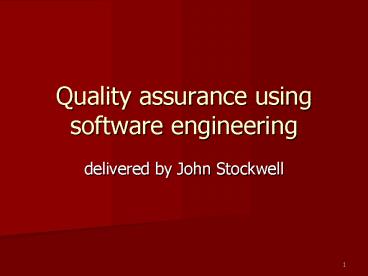Quality assurance using software engineering PowerPoint PPT Presentation
1 / 19
Title: Quality assurance using software engineering
1
Quality assurance using software engineering
- delivered by John Stockwell
2
Objectives
- At the end of this lecture you will be able to
- Describe the quality advantages of adopting a
top-down modular approach to systems design - Explain how quality is enhanced by using the
correct techniques for documenting - Discuss the importance of testing, maintaining
and auditing software
3
QA using software engineering
- Design systems with a top-down modular approach
- Document software with appropriate tools
- Test, maintain and audit software
4
TQM total quality management
- an evolutionary process towards perfection
- Continuous improvement
- Strategic planning and leadership
- Customer focus
- Empowerment
- Teamwork
5
Responsibility for TQM
- Must have management support
- Analysts must consider quality right from the
inception of a project and not merely as an
afterthought to solve problems at the end - Organisational support must exist
- On the job time for IS quality circles
- Guidelines must be developed for quality standards
6
Structured walkthrough
- Use peer reviewers to monitor systems
programming and overall development - Allows analyst and programmer to make revisions
- Co-ordinator, originator of model/code
(analyst/programmer) and analyst/programmer peer
take part - Implemented whenever a subsystem has been
completed
7
(No Transcript)
8
Quality and System Design Approach
- Bottom-up
- Identifies processes to be computerized at the
lowest level of the organization - Makes it difficult to interface with subsystems
interface problems - Duplication of effort in purchasing software and
entering data - Overall organizational objectives not considered
9
Quality and System Design Approach
- Top-down
- Look at the large picture and explode it into
smaller subsystems - Overall organizational objectives considered
- Emphasis on interrelationships between subsystems
- Enables separate analysis teams to work in
parallel - Focuses on what the system is supposed to do as
opposed to individual sub systems - Must manage reintegration of subsystems
- Fits well with TQM
10
Quality and System Design Approach
- Modular
- Used with top down approach
- Breaks program into manageable chunks
- Emphasises interfaces between modules
- Modules are self contained and easy to test,
debug, understand and maintain - Uses structure charts
11
Structure charts
- Structure charts
- Show the relationships among program modules
- Chart symbols represent
- Modules
- Data couples
- Control couples
- Conditions
- Loops
12
Example structure chart
Main_program
Income status
status
Income Status tax
income
tax
Entered_filing_status
Entered_gross_income
Output_results
Computed_tax
Print_status_menu
status
Print_status
13
Software engineering and documentation
- Process and software documentation is necessary
to allow for - New users
- New programmers maintaining system
- Techniques include
- Nassi-Shneiderman charts
- Pseudocode
- Procedure manuals
14
Nassi-Shneiderman charts
15
Pseudocode example
- public boolean moveRobot (Robot aRobot)
//IF there is no obstacle in front THEN
// Move the robot // Add the move
command to the command history // RETURN
true //ELSE // RETURN false without
moving the robot //END IF
16
Code Generation and Design Engineering
- Use of software to create all or part of a
computer programme - CASE tool forward engineering
- See demonstration of Together CASE tool
17
Testing Maintenance and Auditing
- Testing subsystems then whole system
- Testing with test data
- Desk check programs then create test data
- Link testing with data
- Full systems testing with data
- Full systems testing with live data
- Maintenance Practices
- More to improve software than to fix it
- Auditing
- An expert examines information to gauge its
reliability
18
Summary
- The systems analyst uses three broad approaches
- designs systems and software with a top-down
modular approach - documents software systematically using
appropriate tools - Organises testing, maintaining and auditing of
the system and software
19
References
- Dean, Jr., J. W., and Evans J.R., Total Quality,
West Publishing Company, 1994 - Kendall K., Kendall J., Systems Analysis and
Design, Prentice Hall, 2002 (fifth edition)

